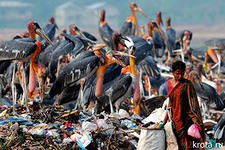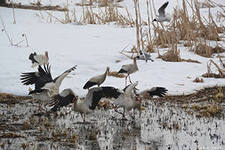- Учителю
- Урок по аудированию Белые аисты
Урок по аудированию Белые аисты



WHITE STORKS.
Pre listening stage.
Look at these pictures. Do you know the names of these birds? They are called white storks. What can you see in the pictures? Where are the natural habitats of white storks? What are they doing among litter and rubbish? What, in your opinion, is the text you are going to listen to about?
Listening to the text «White Storks»
1st listening
Listen to the text and put the pictures in the order the story is told
2nd listening
You are going to hear the article about white storks again. Before you listen, read through some phrases and while you are listening to the text, tick the information it contains.
-
Places of natural habitats
-
The description of the food the birds eat
-
The description of the storks
-
The extinction of birds
-
The storks' natural nesting sites
-
A new threat to storks
-
The weather conditions
-
The reliable source of food
-
Human development
-
The population of a small Spanish village
As I walked along the narrow streets of a small Spanish village, I felt excited at the prospect of being allowed up onto the roof of a beautiful church. My purpose in being there was to take photographs of the white storks which had been seen nesting in the bell tower high above the village streets. In fact, storks had been my ticket into many similar adventures over the years.
Storks are large, beautiful birds with long necks and taking pictures of them is not easy. In towns and villages storks build their nests, which are like platforms made out of twigs, high up on rooftops or treetops. So my initial job was to collect a huge key, let myself into the church, and climb up the bell tower so I could at least see the white stork nest on the roof of the tower.
I eventually reached the top and lifted the door above my head. After the hot, dry streets below there was a wonderful cool breeze and staring at me from their nest about forty metres away were three half-grown storks. It was a marvellous scene, especially in view of the fact that towards the end of the twentieth century there was great concern about the future of the white storks.
The numbers of the storks had been decreasing for various reasons. The major cause for this decrease was due to the lack of rain in West Africa. Storks traditionally escape the European winter and depend on insects and other animals for their food supply. The severe drought caused by hardly any rainfall for years in West Africa had reduced the storks' supply of food with disastrous consequences.
Human development has also affected the stork's ability to survive, but in this case the bird has proved to be very adaptable. In natural environments, the stork nests in trees and on rocks. However, as buildings began to spread onto the storks' natural nesting sites, the birds adjusted to this loss by carrying their twigs even higher. Radio towers, road signs, statues, monuments, chimneys and even pylons carrying electricity have become loaded with piles of twigs.
Another example of the stork's amazing ability to adjust to changes in the environment is its diet. If a stork can't find sufficient food in the natural habitat then it seems it will quite happily feed off it can find in rubbish tips. This reliable source of food is probably one of the reasons why a sizable percentage of the stork populations in Spain no longer migrate by flying off to Africa for the winter.
However, there is a new threat to storks on the horizon. European Union rules and regulations may affect the source of food found on rubbish tips, as governments are now being asked to clean up rubbish tips by covering them over. This will obviously cut off a valuable food supply for the storks. Nevertheless, like any animal or bird which has so successfully adapted to human development, the stork will no doubt find a way to ensure it will survive long into the future.
After listening stage
T/F/NS statements, give the proof from the text
-
My purpose in a small village was tourism
-
Taking pictures of birds was easy
-
The weather was disgusting and I didn't go anywhere
-
Storks manage to survive because they adapt to environmental changes
-
Environmentalists are greatly worried about the future of the white stork
-
White storks and other animals will survive long into the future
-
White storks usually migrate from cold countries.
Describe the pictures to the text, answer the questions:
-
Where does it take place?
-
What can you see in the picture?
-
What is happening there?
-
What can be done to change the situation for the better?
-
Will your classmates support you?
-
Have you ever seen animals in trouble? Did you help them?
You can also use these statements as a plan to tell your partner about white storks or other birds or animals of your region
You can let students listen to the story but not tell them the end. They have to guess what it is and then, perhaps, we play them the recorded version. A variation on this technique is to stop the story at various points and say 'What do you think happens next?' before continuing.
Use the internet and find some more information on survival of animals in changing environmental conditions.
Discuss the following questions with your classmates
What are other ecological problems that people face?
Are these problems the result of people's activity?
Can you personally change the situation for the better?
What is the situation like in the place where you live?
Make a poster to tell people the way they should behave not to destroy animals' habitats, help animals to survive.
Pretend you address your schoolmates on TV. Tell them about the wild animals of your region and their natural habitats, homeless animals, tell them about the responsibility for tame animals.
*Note that the text can be 1 or 2 paragraphs shorter for listening , but for reading it is quite normal. I think there is no need to do it as it is very interesting and not very difficult.
Зрячева Нина Владиславовна
УМК «Новая Матрица»
9 класс с углублённым изучением английского языка